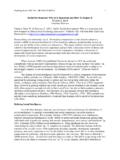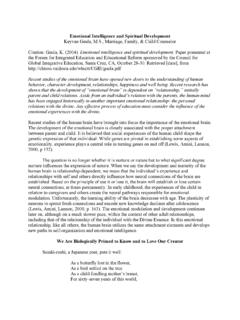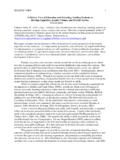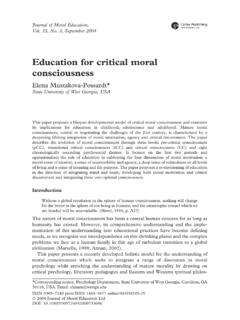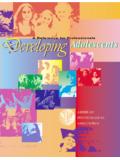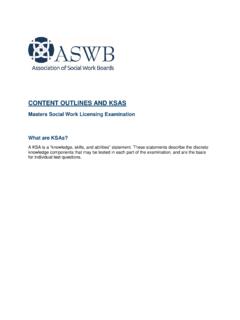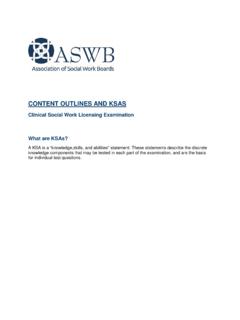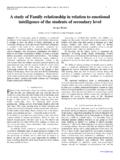Transcription of An Overview of Family Development
1 Family Development 1 An Overview of Family Development Jade A. Enrique, Heather R. Howk, and William G. Huitt Citation: Enrique, J., Howk, H., & Huitt, W. (2007). An Overview of Family Development . Educational Psychology Interactive. Valdosta, GA: Valdosta State University. Retrieved [date], from The Family is the smallest unit of a society and, therefore, critical to its Development and maintenance. There are four major issues in the Development of a Family : mate selection, spousal relationships, parenting , and change. This paper reviews the literature regarding the importance and current state of the Family , the four major issues related to Family Development , and some activities that educators and parents can implement in order to prepare children and youth for Family responsibilities. The paper also discusses ways to measure student s successful Development in these areas.
2 Despite the historic centrality of the nuclear Family unit (mother, father, first-born), there are several definitions of Family . According to the Population Reference Bureau (2000), Family can be a group of people held together by birth, marriage, or adoption or by common residence or close emotional attachment. Families may include persons who claim decent from common ancestors in a lineage, a tribe or a clan (para. 12). Although marriage often signifies the creation of a Family , unofficial joining together endorsed neither by church nor state, are quite commonplace. According to Ooms (as cited in Patterson, 2002), families serve several important functions for society. Some of these functions are: Family formation and membership, economic support, nurturance and socialization, and protection of vulnerable members. However, Levine (as cited in Shaffer, 2000) states that the three basic goals that families have for their children are: survival, economic self-sufficiency, and self-actualization.
3 These three goals are symbolic of various cultures. This shows that although there are several differences in the types of families in the world, they have certain things in common. It is the job of educators to examine the characteristics of families in order to foster most advantageous Development in the children they serve (Christian, 2006). A Changing World The Family system is a basic unit of society that has evolved along with changes in the needs and demands of the individuals and society (Kozlowska &Hanney, 2002). As the smallest social unit of society, the Family has been instrumental to the Development of cultures and nations. The extended Family was the first social unit in the nomadic hunter/gatherer age and grew into families within tribes. The agricultural age somewhat modified the social organization (Bianchi and Casper, 2000), but what did not change until the industrial revolution was the clear connection of children and parents to a larger unit of tribes or clans.
4 The industrial age in western society and modernity brought a decreased connection with the extended Family in many cultures. An increased responsibility on the husband to generate income as a worker outside of Family unit became the norm (Toffler & Toffler, 1995). In recent decades, women have joined the workforce in record numbers, putting increased pressure on both adults to provide the economic resources for the Family . Family Development 2 In advanced industrialized societies, the fate of the nuclear Family is of concern to many researchers, government officials, and citizens. Commentators ask if the Family is falling apart or merely evolving into a new form (Wrigley, 2004). Indicators of Family disequilibrium, such as divorces and the number of children being raised in single-parent families, are rising alarmingly. A discussion of preparing children and youth for the establishment and maintenance of a Family cannot avoid these issues.
5 Instead, relevant literature must be surveyed to clarify the issues and provide insights on how they may best be addressed. Certainly the Family has been the primary social institution for the raising of children. These children need love, support, nurturing, and discipline. In traditional westernized nations, this was thought to be best provided in a two-parent married Family existing within an extended Family structure (Bianchi and Casper, 2000). The two-parent nuclear Family then became the prototype with the woman leaving her relatively low-paying job she got after (or before) finishing high school and taking care of children. She did this while her husband held a steady job that paid enough to support the entire Family . Popularized as the American 1950 s-style traditional Family , around 75% of school-aged children had a parent at home full time.
6 Family structures of this type had to support distinct gender roles and the economy had to be vibrant enough for a man to financially support a Family on his own. Government policies and business practices supported this Family type by reserving the best jobs for men and discriminating against working women when they married or had a baby. In the United States, the 1960 s civil rights and feminist movements resulted in a transformation in attitudes towards Family behaviors (Evans, 2004). People became more accepting of divorce, cohabitation, and sex outside of marriage and less sure about the permanence of marriage. They became more tolerant of blurred gender roles, of a mother working outside of the home, and a variety of living arrangements and life styles. The transformation of these attitudes accelerated in the 1970 s and 1980 s. Consequently, the percentage of children with a full-time parent at home dropped somewhat in the late 1970 to around 57% and is now only around 25%.
7 A new ideology emerged during these years that stressed personal freedom, self-fulfillment, and individual choice in living arrangements and Family commitments. Young people began to wait until their mid- to late-twenties to marry. They began to expect more out of marriage and to leave bad marriages if their expectations were not fulfilled. The changes in norms and expectations about marriage may have followed rather than preceded increases in divorce and delays in marriage; however, such cultural changes have important feedback effects, leading to later marriage and higher divorce rates. Currently, the chances of a first marriage ending are at a high rate--40% to 50%--with the rate increasing to 50% to 60% for second marriages. When cohabitation occurs, as is often the case, the rate of breaking up increases (Evans, 2004). Evans (2004) reported that, of the seventy-three million children under the age of eighteen, about twenty million live in single-parent families, and perhaps as many as nine million in stepfamilies.
8 Each year, an additional one million children experience their parents divorce and another million plus are born out of wedlock (p. 61). More than 25% of all families with children are headed by single parents; the majority by mothers. The difficulty of father absence has been well documented, both in variety and degree of harmful outcomes (Children, Youth & Family Consortium, 2004). For example, father absence is connected with a high rate of school dropouts of teenagers, early sexually activity and teen pregnancy, and juvenile delinquency. Family Development 3 The remainder of this paper will focus on more specific issues surrounding the creation and maintenance of families. Suggestions will also be made as to what educators can do to promote Family Development . Additionally, measurement issues will also be briefly discussed. Issues Surrounding Family Creation and Maintenance There are at least four major issues that must be addressed as parents, educators, and communities prepare children and youth for the responsibilities of creating and maintaining their own families as responsible, successful adults.
9 These are 1) mate selection, 2) spousal relationships, 3) parenting and 4) changing Family patterns. Mate Selection Selecting a mate has traditionally been influenced by a variety of variables related to propinquity (the property of being close together) and homogamy (similarity of important qualities or characteristics). While propinquity is still an important factor, it has been mitigated through geographical and social mobility and increasing use of the Internet. Mobility in post-industrialized countries, resulting from access to the means of acquiring wealth and the lessoning of restrictions of movement, is a central feature of a post-modern society (Birdsall & Graham, 1999). In the last decade, the use of the Internet has become increasingly popular as a means to meet socially and interact with other humans without leaving the home or office (Cioffi, 2003).
10 However, there are several weaknesses of online interactions of which young people need to be aware. First, people are unable to fully express themselves. Nonverbal cues such as body language, facial expression, and pitch or tone of voice, are absent from online interactions. A second disadvantage is the rhythms of impressions are slower and choppier than face-to-face interactions. Delays of a few seconds may convey false hesitation or disinterest. Even those people who meet via the Internet will normally meet face-to-face in order to overcome these disadvantages (Cioffi, 2003). The success rates of these services seem to be fairly low; still people are encouraged to use them due to the speedy access to a high number of potential dates. Being nice and showing respect have been the two most common ways of starting to create a real relationship in person (Brehm, Miller, Perlman, & Campbell, 2002).
